|
|
|
Anza-Borrego Desert
Sunday, May 16 1999
Today Kim and I drove off to the eastern desert, the Anza-Borrego, the site of the largest state park in the lower 48 states.
We headed east on I-8 past El Cajon, traveling into the unpopulated highland scrub country that gradually tops out at an elevation of around 4100 feet above sea level. This divide between the Pacific coast watershed and the arid undrained country to the east is known as the Laguna summit. Instead of turning north and heading along the mountain-plateau to the touristy quaintness of Julian (as we did back in December), we continued farther eastward, down the arid slope towards El Centro. Over the course of 12 miles the scrub broke gradually into the regular scaly pattern indicative of increasingly low soil moisture levels. Eventually the shrubs vanished completely and all that was left were the spiny cholla cacti, some yuccas, and the sea-plantesque Ocotillo, but these plants were only on the hillsides where soil was present. In many places, though, there was no soil whatsoever, just huge rectangular boulders, rocks that had weathered in place or sloughed off the sides of ancient hills into chaotic rubble piles. There were a number of valleys visible from the interstate entirely paved with huge boulders of this sort. Very little plant life was evident in these places. They looked like they belonged on some other planet, particularly Mars. I didn't know places like that even existed here on earth. So, to say the least, I was overwhelmed with the visual intensity of the scenery. Driving by just once wasn't enough for me.
Kim, on the other hand, wasn't satisfied with the view. She wanted to know where we were heading. She didn't see the point in simply driving eastward as a goal in itself. She actually had it in her mind that we'd end up at a desert watering hole, order a margarita and dangle our toes in the pool. But I wanted to just keep driving eastward, all the way to where the land dipped below sea level. We had quite an argument over this issue. When it was clear that Kim wouldn't be happy driving to El Centro, we turned around and heading back west, up off the El Centro plain and back towards the Laguna summit. But, perhaps mainly due to my enjoyment of the scenery, we overshot too far westward and had to double back eastward yet again. Though I was loving the scenery, Kim was sobbing with frustration.
We switched places and I did the driving, this time northwestward on the S2, directly through the heart of the Anza-Borrego State Park.
The landscape consisted of large expanses of flatness divided by steep-walled mountains. This was basin country, drained by no sea-reaching rivers. Any water falling on this ground either ended up in a subterranean aquifer or it evaporated away. Looking at these hills and thinking about the basins (some, such as the large Salton Sea - El Centro basin - sag below sea level), I was strongly moved by the idea that none of the rocks and dirt eroding off these mountains would ever reach the ocean. Everything in this erosion cycle was still trapped here somehow. That meant that the bottoms of these basins must be descending at relatively rapid rate in order to absorb all erosional debris from the mountains. Later on, while Kim was reading a travel guide aloud, I learned that the debris accumulations beneath the flat surfaces of these basins is as much as a mile deep, and that mixed in with all this rock and dirt is a great deal of water, a large fraction of all the water that has fallen on these basins in their several-million-year existence.
At the base of a mountain range we pulled over and walked a short ways out into the desert. Originally we were going to shoot naked pictures or something, but Kim was worried about Sophie being attacked by a scorpion or stepping on a cactus. For her part, Sophie seemed confused by the arid landscape and strange plants. There were no scents for her to follow (though I did see a pile of rabbit droppings). She was a little alarmed to see me walking away from the road, but she tagged along.
I started taking pictures of Kim, taunting her a little, sort of pissing her off. Concerned for Sophie, she scooped up her dog and headed back to the car. Unfortunately, she was paying more attention to me and my camera than she was to her trajectory. She ran right into a cholla cactus. Ouch.
Suddenly we were in a crisis. I ran over and looked at her leg. Her calf, bare beneath the non-protection of a hippie wrap-around skirt, bristled with several dozen spines, each as long as a toothpick but half as thick and 20 times sharper. Droplets of blood were already in evidence. It was like something out of a horror movie. "Can't you see I need a little help here?" Kim whimpered as she held her skirt (also bristling with spines) away from her leg.
Back at the car I pulled the spines out one by one. They didn't come out easy either; they apparently were covered with thousands of microscopic backwards-pointing teeth. Kim didn't complain as I worked though; owing to a chronic medical condition she's developed a high pain threshold. I managed to remove all of the spines except one, which broke off even with Kim's skin.
The cactus incident didn't turn out to be a particularly big deal. Once the spines were gone, the damage was a simple rash. We continued on, semi-aimlessly. Kim still wanted some sort of direction for our desert daytrip, not wanting to "just stand around and look at dirt."
We ended up at a little general store where we bought some beer and a travel guide. This gave us some useful information about the various plants and landforms we were seeing. After reading about the Borrego basin (an island of non-park within the Anza-Borrego State Park), we decided to go check it out.
One of the interesting things about poorly-drained country divided into so many small isolated basins is that every steep ridge marks the boundary of an entirely different bio-geologic realm, bottoming out with a flatland bearing absolutely no geometric relationship to the flatland on the other side. For desert country, the vicinity of Borrego Springs is fairly densely-populated. But it's not like suburban Phoenix or Las Vegas (the ordeal of arriving by road over such steep ridges prevents such development); it has more of an back-to-the-land wild-west/redneck feel. There's definitely a yuppie quality as well, as evidenced by the golf courses (irrigated with water accumulated over the millenia beneath the surface of the basin).
We sat in the shade in front of a Mexican restaurant eating burritos and tacos. The temperature was absolutely perfect, somewhere in the low 80s without a trace of humidity.
Kim wanted to go to a place called the Galleria, but it was closed. Our marijuana had also run out by this point so there wasn't really much to do except head back home. Every now and then Kim's cellular phone would ring and it would be my co-workers, Kevin and the new guy Scott, calling from Kevin's SUV somewhere on the streets of La Jolla. They sounded like they were having a pretty good time.
We saw a live coyote somewhere crossing the road fairly close to Borrego Springs. Though he looked like a dog up close as we passed him, from a distance his movement had an eerie ghostlike quality, completely unlike any domesticated European creature.
We headed back up Mount Laguna towards Julian. I could tell we were closing in on less arid lands once I saw a stream with water flowing in it. The banks and hillsides on either side were just as barren as anything else in the desert, but the strong flow indicated headwaters that experience regular rain.
Within the space of maybe five miles, the hills became covered with fairly dense vegetation. Pine and spruce trees began to appear. Off on the distant ridge to the west were the spires of genuine montane forest. We stopped to have a look at the beautiful countryside, but by some misfortune we found ourselves just up the hill from some sort of redneck festival; below us I could see men with mullets and women with love handles sufficient for maneuvering wheelbarrows.
Kim and I were both drinking beers and had been for the past half-hour or so. Whimsically, when Kim saw large black ants swarming around a little hole, she poured some beer on them. "Why did you do that?" I demanded, "that was mean!" She insisted that she was only trying to give them some beer, and what could be wrong with that. About that time one of the ants bit her on the foot. This bite ended up being the most serious injury of the whole trip. Evidently this particular species of ants secretes a fairly powerful poison in its bite. Kim's foot actually became slightly swollen, as if she'd been stung by a bee. Kim's rash from the cactus incident, meanwhile, was rapidly fading into oblivion.
After passing through Julian, we ended up at Lake Cuyamaca, some sort of touristy reservoir near the Laguna summit not too far from I-8. The beer had made me so sleepy I just wanted to take a nap on the ground along one of the poorly-defined nature trails, but Kim wanted to walk around and "get some exercise." There was nothing at Lake Cuyamaca that interested me in the slightest except for evidence of acorn storage by the species of woodpecker that does such things.
Farther on, very close to I-8, we stopped at a vegetable stand called Pam's Place. Pam was a big woman with red hair and a green parrot who crept around amongst her produce. The air was just a little too cold for parrots, so Pam had her Mexican helper put the bird on the steering wheel of her pickup truck to benefit from the greenhouse effect.
On the way home, Kim and I were eating pistachios and "Kick Ass" turkey jerky (Sophie was enthusiastically eating jerky as well). Pam wasn't the only one selling jerky either; before reaching the 8 we passed several stands devoted entirely to selling the chewy stuff.
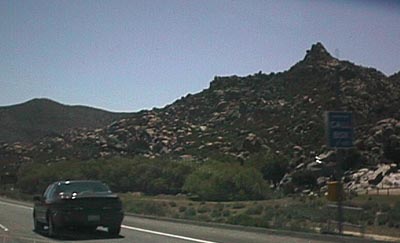
Some of the arid rocky landforms on the east side of the Laguna summit.
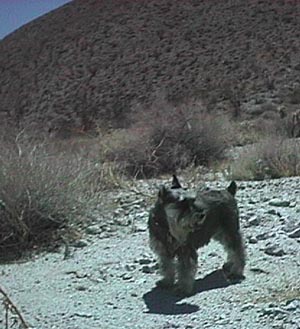
Sophie in the desert. She didn't much like it.
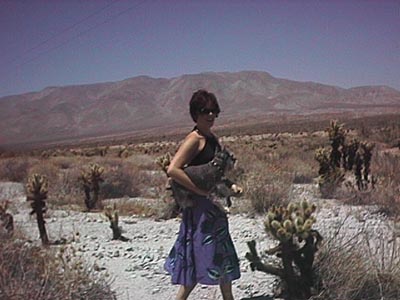
Just before Kim ran into the "Teddybear" cholla cactus you see to her right. The thin wrap-around skirt provided no defense.
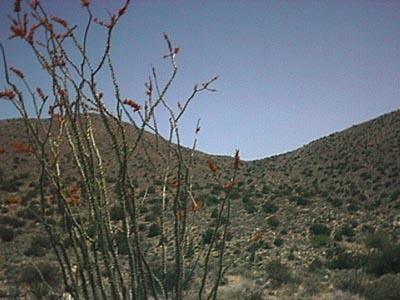
An Ocotillo in bloom.
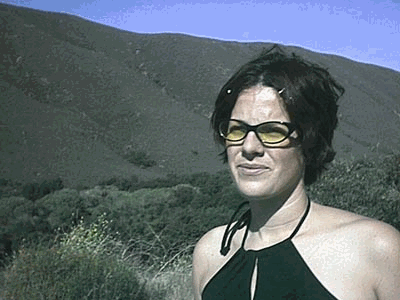
Kim in a high valley just east of Julian and just west of the desert.
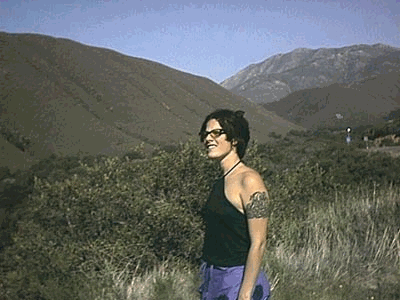
Just before a large black ant bit Kim painfully on the foot (after she gave its colony a drenching beer-party-from-the-heavens).
For linking purposes this article's URL is:
http://asecular.com/blog.php?990516 feedback
previous | next |





